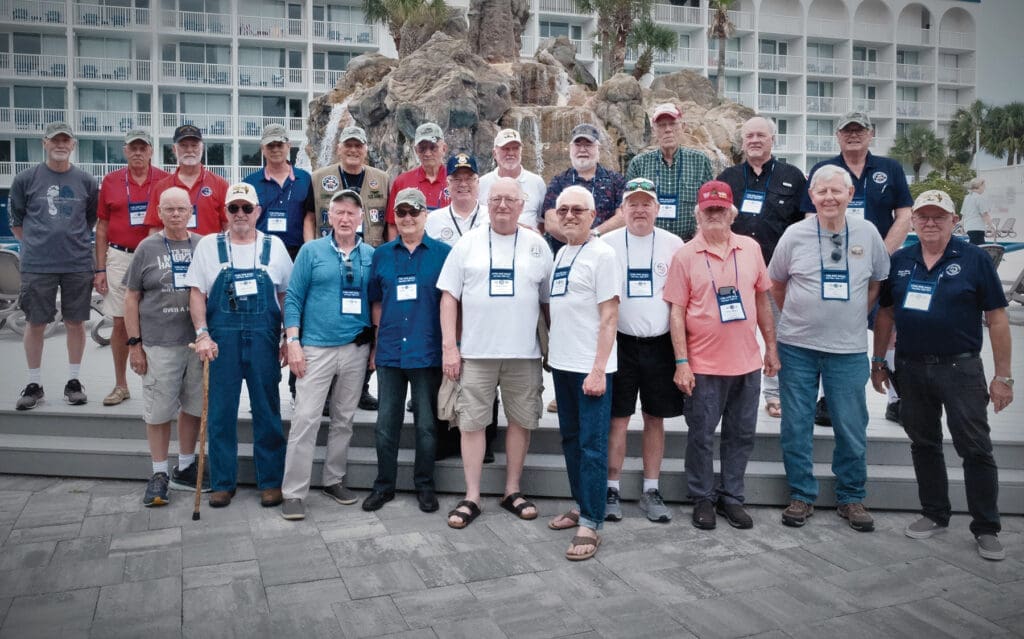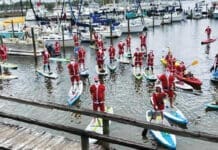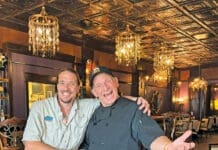By Doug Stauffer
The 174th Assault Helicopter Company (AHC) recently held its 30th reunion at the Island Resort, Fort Walton Beach. I was privileged to meet with them and talk with some of the members.
 When the Vietnam War raged on, the United States military faced numerous challenges in combating the Viet Cong (VC) and North Vietnamese Army (NVA). Among the many units that fought valiantly during this tumultuous period in U.S. history was the 174th AHC, whose bravery and sacrifice deserve commemorating and honoring.
When the Vietnam War raged on, the United States military faced numerous challenges in combating the Viet Cong (VC) and North Vietnamese Army (NVA). Among the many units that fought valiantly during this tumultuous period in U.S. history was the 174th AHC, whose bravery and sacrifice deserve commemorating and honoring.
Established on April 1, 1966, the 174th AHC was essential to U.S. Army aviation during the Vietnam War. The group operated the UH-1 “Huey” helicopters. The company participated in countless operations, including the Tet Offensive in 1968, the Battle of Hamburger Hill in 1969 and the Cambodian Incursion in 1970.
Tragically, the Vietnam War claimed the lives of many brave soldiers who fought for freedom and democracy. Among them were 62 members of the 174th AHC, who paid the ultimate price. The story of the 174th AHC reminds us that behind every statistic and historical record are the lives of real people who fought, suffered and died for this country.
I sat down with Capt. Cliff Stern, a platoon leader who oversaw 10 aircraft during “Operation Lam Son 719,” as he shared his first-hand account. As part of a broader mission in early 1971, the South Vietnamese forces, backed by the United States, aimed to sever the NVA’s supply lines along the Ho Chi Minh Trail in Laos. Known as the “Dolphins,” the 147th AHC provided aerial support to the ground troops throughout this daring operation. The company mainly operated the UH-1 “Huey” helicopters nicknamed the “Sharks,” transporting the South Vietnamese Army and inserting and extracting soldiers in the battle zone.
Stern vividly described the numerous challenges and hazards the 147th AHC faced during the 45-day operation. The helicopter crews were under constant enemy fire, with the NVA maintaining a strong presence and deploying extensive anti-aircraft defenses along the Ho Chi Minh Trail. Despite the odds, the 147th AHC displayed an unyielding spirit. Beginning the operation with a fleet of 35 helicopters, they suffered the staggering loss of 30 aircraft.
I also asked to speak with Wally Nunn, a 24-year-old door gunner at the time, who recalled his experiences during the war. He mentioned a common expression among soldiers that a helicopter was “280,000 parts flying in close formation,” a humorous yet accurate way to describe the complexity and intricacy of a helicopter’s design and functionality. Helicopters have many components that must coordinate precisely for the aircraft to operate safely and effectively. It also underscores the inherent vulnerability of helicopters, as any malfunction or failure in one of those many parts could potentially lead to catastrophic consequences.
They relied on their “Witch Doctors” to ensure the aircraft remained in optimal condition. The term “Witch Doctors” highlights the seemingly magical ability of these maintenance crews to diagnose and repair complex mechanical issues, often under challenging and time-sensitive conditions.
Nunn elaborated on their mission: “Our job was to save people, keep the guys on the ground alive by stopping people from killing people.” He shared an interesting perspective on the war, stating that, initially, soldiers believed they were in Vietnam to win. However, they later realized their role was to hold off the communists until their economy collapsed under the strain of conflict.
Their experiences are a testament to the unbreakable bonds they formed while fighting side by side, not just for their country but for each other. Their sacrifices and unwavering determination, symbolized by their motto “Nothing Impossible,” are a powerful reminder of the courage and resilience of all who served in the Vietnam War. The 174th AHC, their families, and the memories of those who never made it home continue to inspire deep gratitude and respect for their selfless service. Their stories of heroism, sacrifice, and camaraderie are a poignant reminder of the true cost of war and the unyielding spirit of those who answer the call to serve.






























































